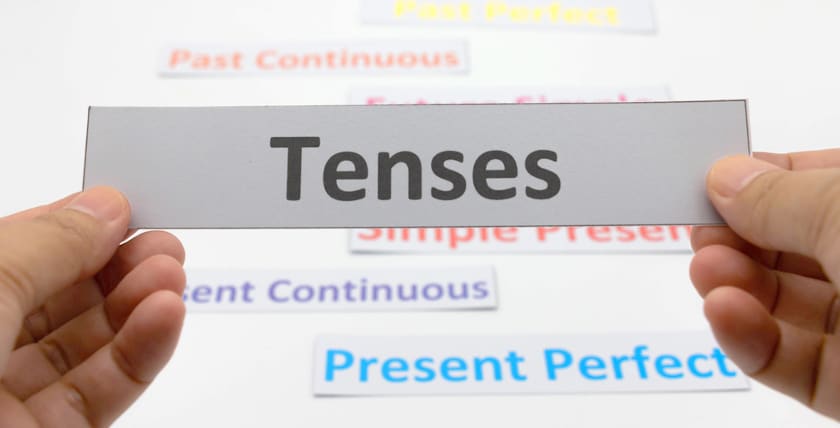A helpful present tense explanation from Andrew Rossiter, author of A Descriptive Grammar of English:
Using the present tense in any language ought to be easy. After all, it’s the first tense we learn about, and it’s the tense we most often use because we use it to talk and write about things that are happening, things that we are doing, our habits, our likes and dislikes, and a whole lot more.
However, in English, there’s a problem with present tense explanation! In Spanish, you can say Bebemos zumo de naranja, while the French say, Nous buvons du jus d’orange. In German, you can say Wir trinken Orangensaft. These expressions mean different things in different situations. But in English…… it’s not quite so simple. However, it’s not too difficult either!
In English, we have something that many other languages do not have, and it’s called “aspect,” and verbs in English have two aspects. Most verbs (though not all) can be used in either of these aspects: the simple aspect and the progressive aspect.
So those Spanish, French and German examples given above can either be, in English, We drink orange juice, or else We are drinking orange juice. And it’s important to distinguish between them.
What’s the difference? Present Tense Explanation
It shouldn’t be too hard to remember. We use the present simple, as in I drink orange juice, to express permanent truths, repeated actions, and sometimes instant actions: so if you said to someone I drink orange juice, you would be implying something like:
I like orange juice (so I’ll be happy to have a glass).
Or, I regularly drink orange juice (for example, I have some at breakfast every day).
I’m the one who drinks orange juice.
Present Continuous or Present Progressive
By contrast, we use the present continuous, also called the present progressive, to express actions or conditions that are developing, ones that are in the process of taking place, or actions that are going to take place. So if you said I’m drinking orange juice, you would be implying something like:
I’m drinking orange juice right now (because I’m driving home after the party).
Or, I’m drinking orange juice at this moment (but usually I prefer coffee).
I’m drinking orange juice today, but tomorrow I’ll be drinking beer.
In the last example, we use the continuous aspect of the present tense as if it were a future tense. Sometimes we use the simple present tense to refer to future actions, but not nearly as often as we use the present continuous.
Four sentences
Here are four sentences to remember. They use one verb in the present simple, and one verb in the present continuous. Therefore, they clearly illustrate the differences between them.
My brother normally works in London, but right now he’s working in Paris.
I often walk to work, but it’s raining, and I’m not walking to work today.
I go to New York every month, and I’m going there again tomorrow.
He usually takes sugar in his coffee, but he’s not taking it now as he wants to lose a few kilos.
Note how an adverb or adverb phrase of present time, such as right now, at this moment, today is often found in sentences where the verb is in the present progressive. However, this is not essential since the adverb phrase of present time may just be implied, not stated.
Tip from Shelley
Every student should personalize their four sentences with things that are true for them. This way, the sentences will be much easier to remember.
Are there exceptions? You bet!
There are, however, a small number of English verbs that are rarely used in continuous or progressive forms. The most common of these are verbs that by their nature express something constant or permanent, verbs like know, like, understand, mean, own, etc. For example, we can’t say, ‘I’m knowing him.’ Well, we could, but it would be pointless because ‘I know’ implies a permanent condition; either you know, or you don’t know. On the other hand, you can say, ‘knowing him, he’ll be late.’ However, it was naughty of me to mention that since it confuses things, LOL!
Examples:
I understand what you mean.
I like strawberries, but I don’t like pineapples.
He owns three Rolls-Royces and a Lamborghini.
Using the progressive aspect of the verb in any of these examples would be wrong; these verbs, by definition, express a permanent and ongoing situation.
Modal verbs
Finally, we never use the progressive aspect with modal verbs! We say I can, I must, and I would, but there is no such thing as a progressive aspect for modal verbs. Nobody ever heard “I am musting!” Forget it! It doesn’t exist.
Discover more about this, and clear explanations of all the main points of English grammar, illustrated with lots of clear examples, in the new Descriptive Grammar of English, also available in French as Nouvelle Grammaire descriptive de l’anglais contemporain.
For more details and to buy an ebook or paperback, visit Linguapress for A Descriptive Grammar of English by Andrew Rossiter.
Posts on present tenses by Shelley
Here are some blogs from Shelley with lesson plans on teaching present tenses:
Teaching the present continuous to teens

